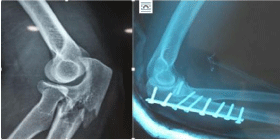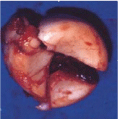
Research Article
Austin J Orthopade & Rheumatol. 2020; 7(1): 1082.
25 Cases Results of Surgical Treatment of Radial Head Fractures
Badaoui R*, Elmaqrout A, Mekaoui J, Boukhriss J, Chafry B, Benchaba D, Bouabid S and Boussouga M
Department of Traumatologie and Orthopedic II, Military Hospital Mohammed V, Faculty of medicine and pharmacy of Rabat, University Mohammed V. Rabat, Morocco
*Corresponding author: Badaoui R, Department of Traumatologie and Orthopedic II, Military Hospital Mohammed V, Rabat, Morocco
Received: January 13, 2020; Accepted: February 03, 2020; Published: February 10, 2020
Abstract
Fractures of the radial head represent six percent of all fractures and onethird of Morrey’s elbow fractures. Their prognosis is usually good, however they can disrupt the function of the elbow. Treatment depends on the type of fracture and associated lesions. Our work focuses on 25 cases of fractures of the radial head at the traumat orthopedic service II of the Mohammed V RABAT military hospital, over a period of 3 years, stretching between January 2014 and December 2016. The aim is to evaluate the functional results of surgical treatment of fracture of the radial head. All our patients treated surgically, divided between osteosynthesis and resection of the radial head according to the type of the fracture and the associated lesions. Early mobilization has been respected in all our patients. The functional results after a follow-up of 24 months, were evaluated according to the Mayo -clinic score. They were 48% good, and bad 14%. Thanks to the progress of osteosynthesis, the resection remains limited to the comminutive fracture.
Keywords: Fracture of the Radial Head; Osteosynthesis; Resection; Mobilization
Introduction
Fractures of the radial head are frequent articular fractures of the elbow. They affect the young and the active subjects, most often following a fall or a high energy trauma. This type of fracture poses a diagnostic problem in the case of fractures with little or no displacement, and a therapeutic problem especially if there are associated lesions. Treatment depends on the type of fracture, degree of displacement and lesions; However, the surgical treatment of complex and displaced fractures of the radial head has undergone a real evolution through osteosynthesis or arthroplasty. The functional prognosis is brought into play by the increased risk of stiffness of the elbow.
Materials and Methods
This retrospective study of 25 cases was conducted in the trauma department orthopedic II at the Mohammed V military hospital in RABAT, over a period of 3 years, stretching between January 2014 and December 2016.
All our patients underwent a clinical examination, radiological examination of the elbow (face profile and ¾), which made it possible to pose the diagnosis and classify the fracture according to MASSON. X-rays of the joint on and below the elbow were completed. 10 patients had Computed tomography. All our patients received surgical treatment, the principle of early mobilization was respected. The functional results were evaluated according to the functional score of the Mayo-clinic. Our functional results were excellent in 48%, good in 26%, average in 12% and poor in 14% of patients. The anatomopathological type and the associated lesions remain the determining factors of prognosis.
Results
The average age of our clients was 32 years, predominantly male. 58% of cases were affected from the leftside.The indirect mechanism was the most frequent 92% (fallon the hand in pronation). The trauma was due to public road accident (48%), sports accidents (30%). Functional impotence of the traumatized upper limp was the most frequently encounteredsign, it was associated with pain of localization and intensity varying according to the patients underwentradiological exploration. According to the MASON classification modified by MORREY, 4% of patients with a MASON 1 fracture fracture werefound, 56% MASON 2, 24% MASON 3 and 16% MASON 4 (Figure 1). Luxation of the elbow was associated with fracture of the radial head in 4 patients, terrible triad of the elbow in 2 patients (Figure 2), avulsions of the brachial triceps 01 case (Figure 3) and fracture of the ext sup of the ulna 01 cast (Figure 4). No vascular or skin lesions. All of our patients hadundergone surgical treatment, using CADENAT postero-external approach (the most used) or pure external treatment, either by osteosynthesis (screwing) 68% or resection (partial or total) (Figure 5), with treatment of related lesions.

Figure 1: Elbot X-Ray shoping à Masson 2 radial Head fracture trente by
screening.

Figure 1: Elbot X-Ray shoping the terrible triade of the elbot trente by
screening the Head and the coronoïde procès.

Figure 3: Elbot X-Ray and CT shoping fracture of the radial head and
avulsion of the brachial triceps trente by réinsertion of the brachial triceps and
résection of the radial head.

Figure 1: X-Ray of the elbot shoping fractures of the radial Head and super
extrémité of the ulna trente by screening the head and ulna plate.

Figure 5: Clinicat Picture of a Masson 3 radial head.
No arthroplasty was performed. All our patients whohave undergone their rehabilitation in a specialized center. In the postoperative period, there were 3 cases of elbow stiffness (benefited from arthrolys). 1 case of periarticular ossification and 1 case of disturbance in pronosupination. The averagefollow-up in our study was 24 months. According to the Mayo clinic score, our functional results were excellent in 48%, good in 26%, average in 12% and poor in 14% of patients. The anatomopathological type and the associated lesions remain the determining factors of prognosis.
Discussion
The fracture of the radial head represents 2 to 6% of all fractures and 20 to 45% of elbow fractures [1-5]. All studies, Le Couteur, et al. [1], Cassagnaud, et al. [3], Obert, et al. [6], Dreoua N, et al. [10], Ben Zerouk, et al. [11] confirm that fractures of the radial head affect the young and old adult average with male predominance, which is consistent with our series. In the series of Mabit, et al. [1] and the other of Gabrion, et al. [12], the falls are in the first rank as etiology, however in our series the public road accident are the most frequent. Many classifications have been adopted to classify fracture of the radial head, in our series we used the classification of MASON modified by Morrey which showed us a clear predominance of fracture MASON 2, on the other hand, in the series of Chauvet, et al. [13] or Zertah, et al. [14], the MASON 3 fracture is predominant. The goal of fracture treatment of the radial head is the recovery of a painless, stable and mobile joint. Several surgical techniques have been proposed for treating these fractures dominated by osteosynthesis and resection.
The indication for resection is mainly in comminuted fractures without associated ligamentous lesions. Hall and Mckee, et al. [15] found cases of rotational posterolateral instability in a series of patients treated by radial head resection, Cassagnaud and Maynou, et al. [3] reserve this indication to elderly patients when the fracture is isolated, comminutive, and not accessible to osteosynthesis. In our series, 8 patients treated by resection with results that are not satisfactory. Conservative treatment with pins, screws or plates (in L or T) has become a treatment of choice for MASON 2 even comminuted fracture. A comparison between resection and internal fixation in comminuted fractures of the radial head demonstrated that functional results with internal fixation are better than resection. The radial head should be preserved if it is synthesizable, even in the case of a comminuted fracture In our series, patients treated with osteosynthesis have satisfactory results. All the authors confirm the importance of the rehabilitation of the elbow. In the long-term complications of resection, arthroplasty has found its place in the management of these fractures. The prosthesis has the advantage of giving a joint that respects anatomy, reduces pain, provides intrinsic stability and eliminates the migration of the radius but it alone does not provide stability if there are other associated lesions [15].
Conclusion
Fractures of the radial head are relatively infrequent, especially in young and active adults. The lesion association is frequent, it influences the management and the functional result of the elbow. The osteosynthesis allows to obtain an integral restitution of the radial head and allows an early mobilization, from where its indication in the fractures of the radial head type II. The prosthesis of the radial head in comminuted fractures remains preferable to resection in the presence of destabilizing lesions of the elbow. Early rehabilitation helps prevent stiffness of the elbow.
References
- Mabit C, Frieh M, Heim U, Laulan J, Lecouteur P, Lenen D, et al. New and old fractures of the radial head. Ann Orthop West. 1994; 26: 151-193.
- Guha A, Jago ER. A new technique of fixation of radial head fractures using a modified tubular plate. J Postgrad Med. 2004; 50: 113-114.
- Cassagnaud X, Maynou C, Mestdagh H, Labourdette P. Influence of the method of measurement of the muscular force in the results of the isolated resections of the radial head in the adult. Ann Chir Main. 1998; 17: 175-185.
- James B, Bennett J. Radial head fractures diagnosis and management. J should Elb Surg. 1993; 2: 264-273.
- Liow RY, Cregan A, Nanda R, Montgomery RJ. Early mobilization for minimally displaced radial head: fractures is desirable: A prospective randomized study of two protocols Injury. 2002; 33: 801-806.
- Obert L, Lepage D, Huot D, Givry F, Clapaz P, Garbuio P, et al. Fracture of the non-synthesizable radial head: resection Swanson implant or prosthesis? Comparative retrospective study. Chir of the hand. 2005; 24: 17-23.
- Dreoua N. Fractures of the radial head: About 61 cases. Thesis Doctorate Medicine, Casablanca.1997; 208-131.
- Ben Zerrok O. Fractures of the radial head: About 61 cases. Doctoral Thesis Medicine, Rabat. 2004; 133-134.
- Gabion A, Havet E, Bellot F, Travan F. Recent fractures of the radial head associated with an instability of the elbow treated by prosthesis with movable cup of judet. Rev Chir Orthop. 2005; 91: 407-414.
- Chovett J, Casanova G, SHOSSARD JF. Processing by prosthesis of the radial head. Rev Chir Orthop. 1995; 298.
- Zerta H. Complications of fractures of the upper extremity of the two bones of the forearm Thesis of doctorate in medicine, Rabat. 2003; 161.
- Yasin NF, Singh VA. Fracture dislocation of the radial head: radial head excision or replacement? The Internet Journal of Orthopedic Surgery. 2008; 8: 1.
- Businger A, Ruedi TP, Sommer C. On-table reconstruction of fractured fractures of the radial head. Injury. 2010; 41: 583-588.
- Ring D. Displaced, unstable fractures of the radial head fixation vs. replacement--what is the evidence? Injury. 2008; 39: 1329-1337.
- Lim YJ, Chan BK. Short-term to medium-term outcomes of cemented vitallium radial head prostheses after excision for radial head fractures. J Shoulder Elbow Surg. 2008; 17: 307-312.